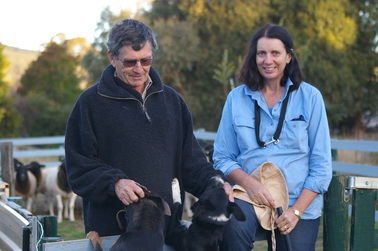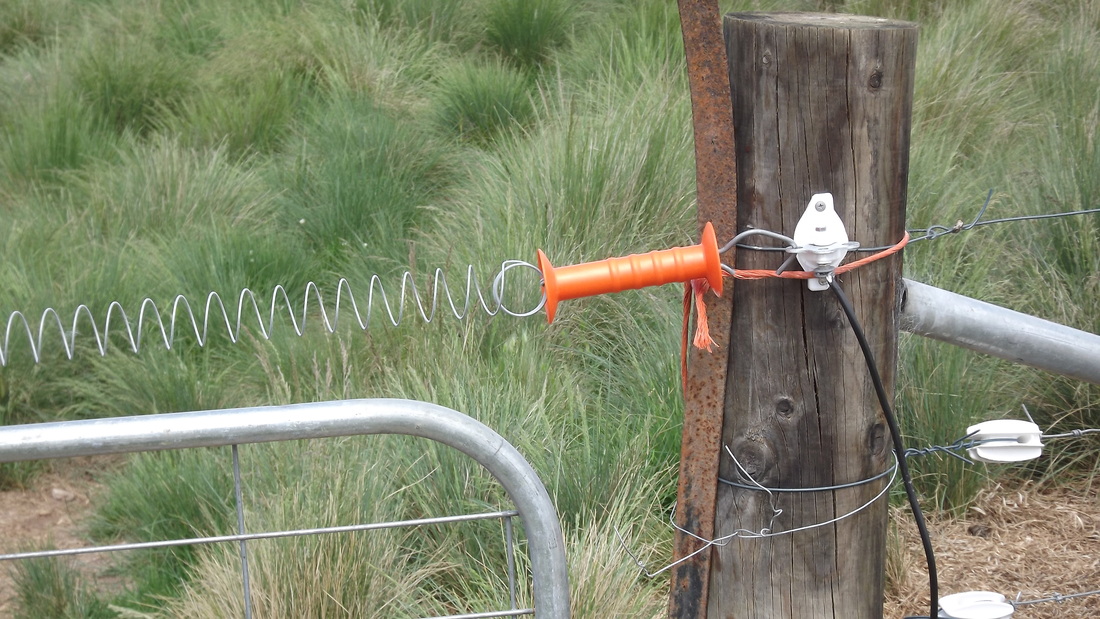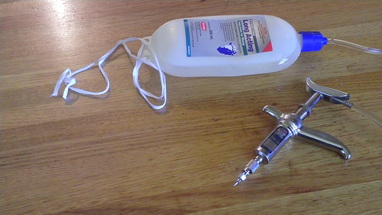The beautiful evening turned into eight hours of storm with rain bucketing down on and off all night and has carried on all day. Nothing compared with folks around Moree in Northern NSW but still quite dramatic. This time last year we had floods at Captains Flat and Queanbeyan fortunately the conditions do not seem right for a repeat. Despite the huge winds and spectacular lightning we didn't have any damage or the inconvience of a blackout, we only lost phone service which can happen with any old rumble of thunder.
0 Comments
Sometimes we have evenings here that I just love, when a big storm is building and the light is just right and the green of the paddocks and trees just seems to glow. Just beautiful.
When we first came to Riverbourne, about seven years ago, the pastures were of poor quality, and the only stock had been a few horses. Since running dorpers, and fencing into small paddocks, the grasses have improved dramatically. I think the dorpers have largely contributed to this by their grazing habit of constantly moving whilst being non selective in their choice of grasses, this means their manure is spread over the whole paddock, and the humus is building up in the soil. They don't tend to just graze a sweet spot, until they have eaten the whole plant roots and all! (My Merinos used to do this, especially in dry times).
Microlaena is a very important grass on the Southern tablelands, being winter active, highly nutritious and responds well to increases fertility, and it is this native grass in which we have seen most improvement. Of course it is important to remember that every time you send an animal off the farm, it takes with it a lot of minerals that have come from yours soil. These need to be put back either by application to the soil, or, better I think, by providing mineral licks, we use a powdered lick, though a lot of farmers find lick blocks are satisfactory. The thoughts behind this fence were that we needed to slow the foxes' passage through the fence so that ideally, it would receive at least two electric pulses. The problem is always exacerbated by undulating country, so post spacings are determined by the terrain. The basic structure is an electrified hingejoint/ringlock fence and a secondary offset electrified wire and earth. We used a special steel post called "cliplock ", which have an insulated plastic insert along one side that is designed to work as an insulator and holder for the hingejoint. The hingejoint is strained and just clipped into the holders on the post. While the design idea of these post is excellent we have found the quality to be very poor and the plastic insert breaks easily and does not exactly fit the wire spacings on the hingejoint. We have since been told of another post "Fibopost XT", (www.sammindustries.com.au) that is a conventional starpost design, made out of a recycled material that doesn't conduct electricity and is very strong. This could be a sturdier, cheaper option. The offset wires were run out using wooden ironbark droppers (drilled to take the tie wires), though a cut down Fibopost would work.The dropper is attached to an earth wire at the top. The bottom wire is live and 20 cm above the ground and 30 cm out from the hingejoint, the wire above is an earth and about 20 cm above the live. We felt that this setup would work best with the very uneven ground where the lambing paddock is sited. We had the challenge of locating the paddock where there would be plenty of shelter for the lambing ewes as well as being possible to fence. The gateway has also received special attention, with the gate being swung very low so nothing can go under it, and along the top we placed a spring electric gate wire, to discourage anything climbing over. This same spring gate could be used at the bottom of the gate as well if there was a gap. We found this fence to be very effective, we didn't lose any lambs from this area, and stillborn lambs were left untouched.(Except by crows)
We have had some requests for more information about our electric fences for predator control, so here goes. When we first moved to "Riverbourne" there were very few internal fences and we needed to get some in place as quickly and cost effectively as possible. So we decided to go electric, this has worked very well and during the drought required minimal maintenence. However, with the last two wet years the need to keep the grass down under the fences to stop them from shorting has become a bit more challenging and spraying the fences lines with Roundup is time consuming. The fencing has also had the benefit of making our place less attractive to other animals such as wild pigs who tend to go round us to the neighbours rather than come through the fences.
The wire configuration on the fences varies with the paddock's usage, if you just want to keep sheep in, three or four wires will do, but for predator control Gallager, who make electric energisers, recommend an earth wire 2" above the ground, live 4" above that, earth 4" above, live 6"" above, and so on. We built a lambing paddock like this near the house and for the first few years it worked very well and we didn't lose many lambs to foxes. In the last couple of years we have found that the foxes are coming in more often, maybe they have learnt the fences weak spots, or they learn to move quickly through the fence and only get a shock occasionally. Hunger is a great motivator. The plain wire also makes it easier to get the carcase out of the paddock. So when we needed a lambing paddock on the other block Electric Fence #2 was developed. Sometimes it is easy to forget the need to be prepared. Not just for fire and flood, but for the smaller emergencies that can arise. This came home to me last week. We had been away for the day and on the way home I noticed the petrol was very low, "no worries", I thought, will fill up on Monday morning (when our local shop and service station is open). However, the plan went awry when my daughter became ill during the night and needed to go to hospital in Canberra an hour away, and 50kms to the nearest Petrol station. The low fuel level made the trip additionally stressful, (add in two of the biggest wombats I have ever seen and the vomiting passenger). It was a lesson in making sure we are well equipped when something unexpected occurs. From now on I will be making sure the fuel in the car is adequate for the trip to town, that we have plenty of batteries for the radio and torches, and the first aid kit is well stocked, small precautions that can make a difference when things go wrong and you live out of town. Three weeks earlier, same daughter, same trip to hospital but this time I was in Canberra already. Heading towards the hospital, I thought everything was very dark then realised that my headlights were not working. Fortunately all the street lighting made the trip possible. Had I been at the farm it would have been impossible. Another lesson.
Today we vaccinated our rams with 6-1 vaccine (we use the one with Vitamin B12 and selenium) Although the vaccination of the ewes is done 2-3 weeks before lambing, and the lambs at marking,( with a booster 3-4 weeks later), people often forget the rams' annual booster. The vaccine is particularly important to prevent Pulpy Kidney, this occurs on rich pasture and in very good seasons needs a booster in 6 months. It usually affects the fattest lambs. and the dead lamb looks as though it has suffered bloat.
Some poddy lambs never get over the pleasure of drinking milk, "Princess" was a poddy from last year and on discovering the milk train, she couldn't believe her luck. She had to be banned from the yard to stop her driving the little lambs off and tucking in. One of our clients sold a ram lamb to a neighbour across the main road ( about a kilometre away). Two days later he was back home in the paddock with his mother. We usually hear stories of people losing sheep, not homing sheep.
Well, not exactly in the rain, it was hanging in the sheepyards under a shelter when a huge storm came through, it got wet and died. Now we needed a new camera, should be easy, we will just get another one the same. Not possible- technology has moved on. I wanted a view finder as it is hard to see the LCD screen in bright daylight, that requirement, seriously limited our choice. None of the small tough looking cameras have them anymore, so we now have a larger bulkier camera. Surely I'm not Robinson Crusoe having a problem framing a picture outside, with just a screen. When you blog, you need photos.
Lambing is finally finished and all the lambs are marked the ewes drenched and injected with a long acting dewormer and all moved onto fresh pasture. We should have a break in our workload now until weaning in Jan/Feb. This is the first time we have used the Cydectin Long Acting Injection for sheep, we are hoping that it will carry the flock through until weaning without needing to drench again. The company info says: "This new formulation of Cydectin Kills resident worms and protects sheep against new infection by small brown stomach worm and barber's pole worm for at least 91 days and by black scour worm for up to 49 days". We will watch and evaluate. We were considering using the long acting capsules that are placed in the stomach. However, we saw the size of the capsule and the equipment to insert them and decided it was not for us, people told us stories of success with this capsule as well as stories of sheep being killed with incorrect insertion.We preceded the injection with a broad spectrum ( 3-1) oral drench, this removes any resistant worms. An expensive business, but hopefully, will save us in time and effort.
The additional benefit of this program, is that it actually helps to reduce worm numbers on the pasture, the sheep acting as a sort of vacuum cleaner for worm larvae. |












 RSS Feed
RSS Feed